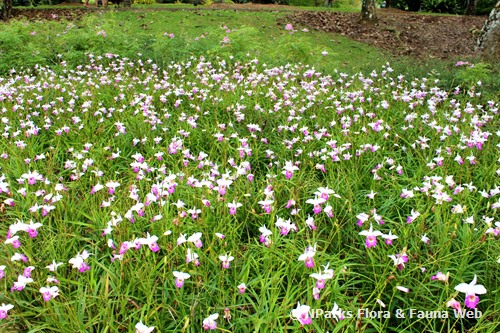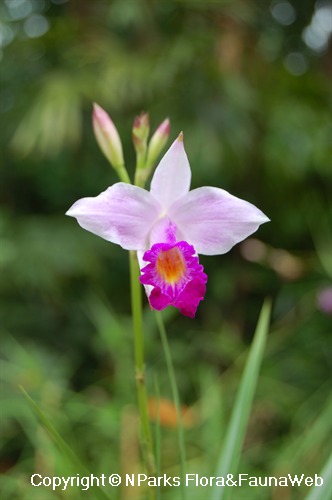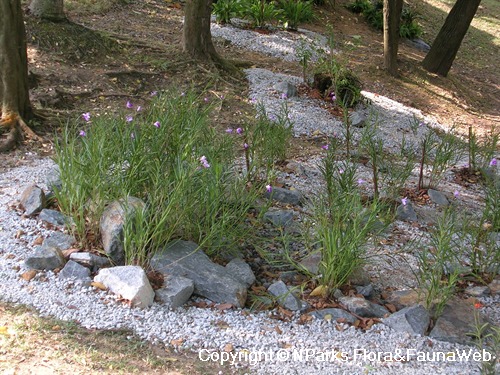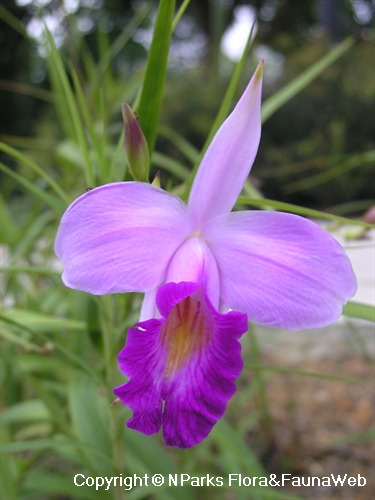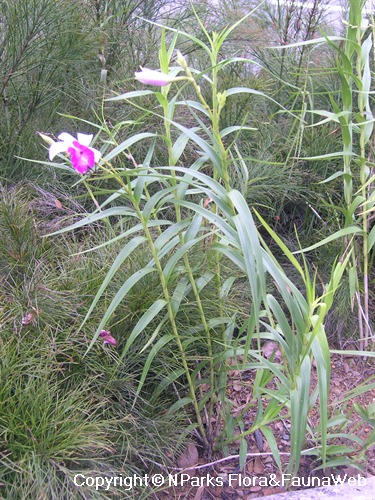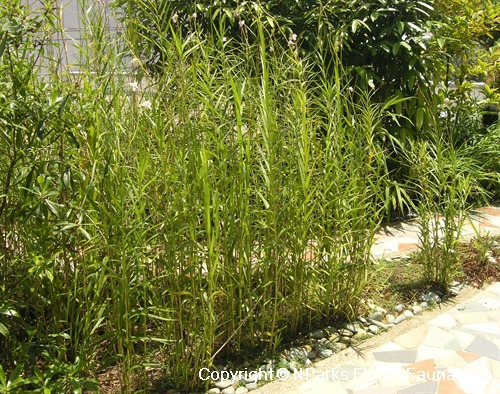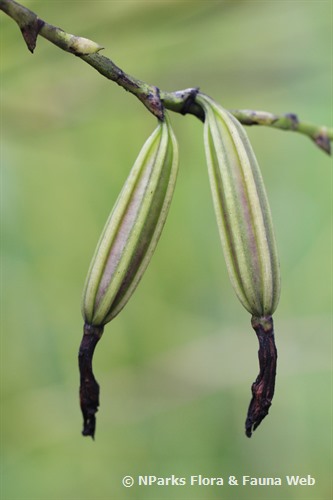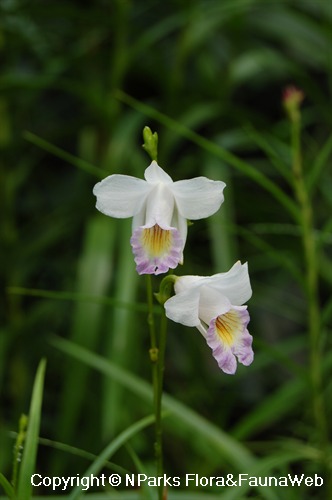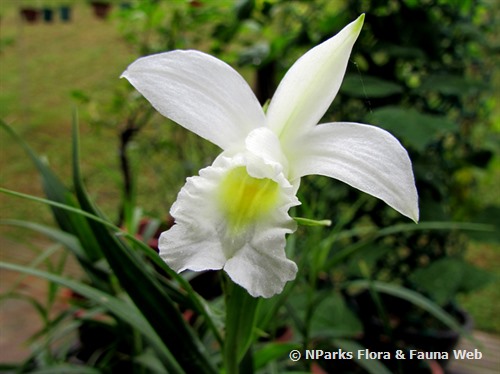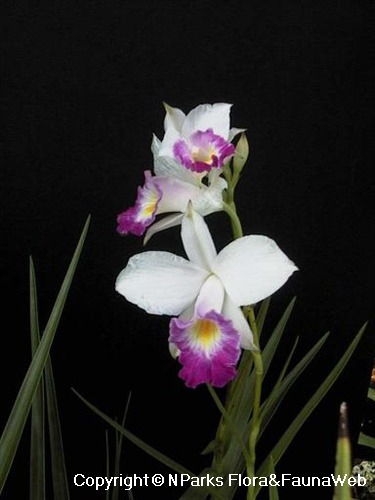
Back
Arundina graminifolia (D.Don) Hochr.
| Family Name: | Orchidaceae |
| Synonyms: | Arundina graminifolia var. chinensis, Cymbidium bambusifolium, Arundina speciosa, Arundina chinensis, Bletia graminifolia, Arundina bambusifolia |
| Common Name: | Bamboo Orchid, Bird Orchid, Kinta Weed, Phanyar, 竹兰, 竹叶兰 |
Name
Classifications and Characteristics
| Plant Division | Angiosperms (Flowering Seed Plants) (Monocotyledon) |
|---|---|
| Plant Growth Form | Herbaceous Plant |
| Lifespan (in Singapore) | Perennial |
| Mode of Nutrition | Autotrophic |
| Plant Shape | Shrubby, Grassy |
| Maximum Height | 1.2 m to 2.5 m |
Biogeography
| Native Distribution | Tropical and subtropical Asia from the Himalayas to Tahiti |
|---|---|
| Native Habitat | Terrestrial (Secondary Rainforest, Monsoon Forest, Disturbed Area / Open Ground, Mountain, Riverine, Grassland / Savannah/ Scrubland) |
| Preferred Climate Zone | Tropical, Sub-Tropical / Monsoonal |
| Local Conservation Status | Native to Singapore (Vulnerable (VU)) |
| CITES Protection | True (Appendix II) |
Description and Ethnobotany
| Growth Form | It is a clumping herb consisting of leafy, erect stems joined at the base, up to 2.5 m tall. |
|---|---|
| Foliage | Its alternate leaves are grass-like. |
| Flowers | Its large, 5 by 5 cm flowers develop in shoots at the tips of the stems. Its three sepals and two lateral petals are white to pink. The third petal is modified to a bright rosy purple lip with a central yellow patch. |
| Fruit | Its fruit is a cigar-shaped capsule that splits to release the tiny, wind-dispersed seeds when ripe. |
| Habitat | The bamboo orchid is found occuring naturally in lowland secondary forests, right up to higher altitudes in the tropical montane forests. Its natural habitats include open areas, grassland, mountains and rock places by streams. Unlike many epiphytic orchids, which are found growing on trees, this orchid is a terrestrial species. |
| Associated Fauna | Ants are known to visit the flowering parts of the plant, while the flowers are bee-pollinated. |
| Cultivation | The bamboo orchid prefers well-drained moderately moist to moist soil, full sun, high humidity and good air circulation. The soil should also not be allowed to dry out between waterings. In the absence of adequate light, the plant will not flower. |
| Etymology | The genus name "Arundina" is derived from the Greek word, "Arundo" (αρυνδο), in reference to the reed-like stems of the plant, while the specific epithet "graminifolius" comes from the Latin "gramineus" and "folius", which refer to the grass-like leaves. |
| Ethnobotanical Uses | Edible Plant Parts : Edible Flowers Food (Fruit or Vegetable): A highland variety of the bamboo orchid are used by locals in East Malaysia as a vegetable. Its flowers are first stir-fried, and said to have a bitter taste, like bittergourd, and are useful in controlling high blood pressure. Others: Occasionally cultivated as an ornamental plant for its flowers, the plants are free-flowering throughout the year once established in optimal conditions. |
Landscaping Features
| Landscaping | It can be a flower-bed ornamental plant, grown for its pretty flowers. Once established, plants are free-flowering. It is suitable for streetscapes, parks and gardens. |
|---|---|
| Desirable Plant Features | Ornamental Flowers, Ornamental Form |
| Landscape Uses | General, Suitable for Roadsides, Parks & Gardens, Small Gardens, Suitable for Rooftops, Riverine, Flowerbed / Border |
Fauna, Pollination and Dispersal
| Pollination Method(s) | Biotic (Fauna) (Insects (Bee), Insects (Ant, Beetle, Fly, Thrip, Wasp)) |
|---|---|
| Seed or Spore Dispersal | Abiotic (Explosive Dehiscence) |
Plant Care and Propagation
| Light Preference | Full Sun |
|---|---|
| Water Preference | Moderate Water, Lots of Water |
| Rootzone Tolerance | Moist Soils, Waterlogged Soils (Drains Site), Well-Drained Soils, Easy to Grow |
| Maintenance Requirements | Moderate |
| Propagation Method | Seed, Division, Aerial Plantlet |
Foliar
| Foliage Retention | Evergreen |
|---|---|
| Mature Foliage Colour(s) | Green |
| Mature Foliage Texture(s) | Smooth |
| Foliar Type | Simple / Unifoliate |
| Foliar Arrangement Along Stem | Alternate |
| Foliar Attachment to Stem | Sessile |
| Foliar Shape(s) | Non-Palm Foliage (Linear) |
| Foliar Venation | Parallel |
| Foliar Margin | Entire |
| Foliar Apex - Tip | Acuminate |
| Leaf Area Index (LAI) for Green Plot Ratio | 3.5 (Shrub & Groundcover - Monocot) |
Non - Foliar and Storage
| Stem Type & Modification | Herbaceous, Cane |
|---|---|
| Specialised Storage Organ(s) | Underground |
Floral (Angiosperm)
| Flower & Plant Sexuality | Bisexual Flowers |
| Flower Colour(s) | Pink, White, Purple, Yellow / Golden |
|---|---|
| Flower Grouping | Cluster / Inflorescence |
| Flower Symmetry | Bilateral |
| Individual Flower Shape | Labiate / Lipped |
| Flowering Period | Free-Flowering |
| Flowering Habit | Polycarpic |
Fruit, Seed and Spore
| Mature Fruit Colour(s) | Black |
|---|---|
| Fruit Classification | Simple Fruit |
| Fruit Type | Dehiscent Dry Fruit , Capsule |
Image Repository
Others
| Master ID | 394 |
|---|---|
| Species ID | 1690 |
| Flora Disclaimer | The information in this website has been compiled from reliable sources, such as reference works on medicinal plants. It is not a substitute for medical advice or treatment and NParks does not purport to provide any medical advice. Readers should always consult his/her physician before using or consuming a plant for medicinal purposes. |

